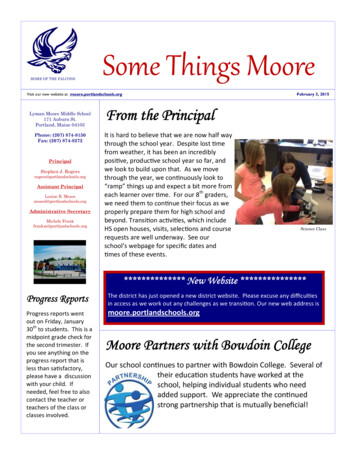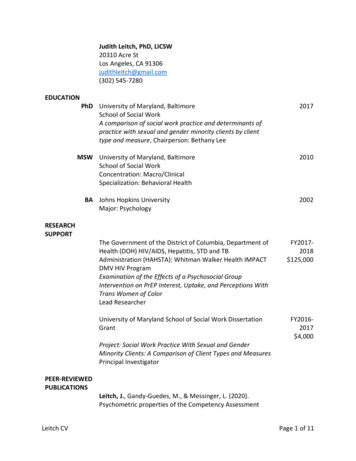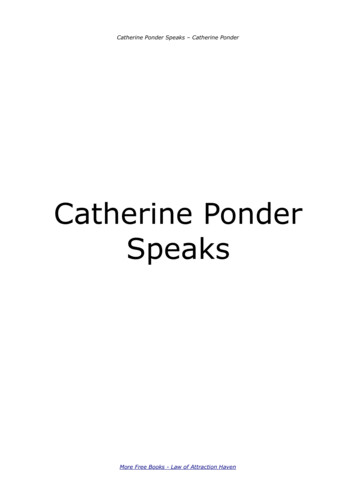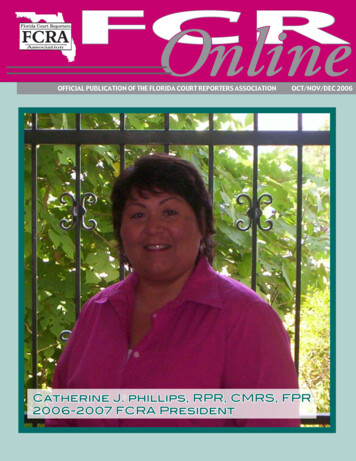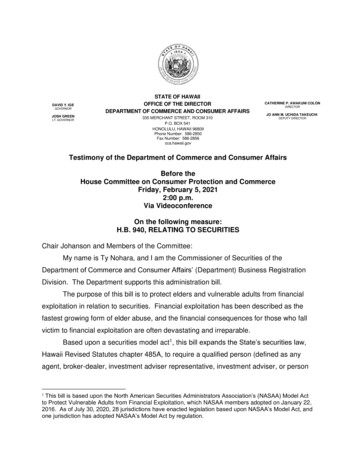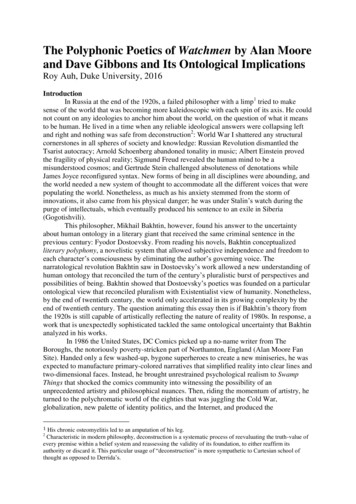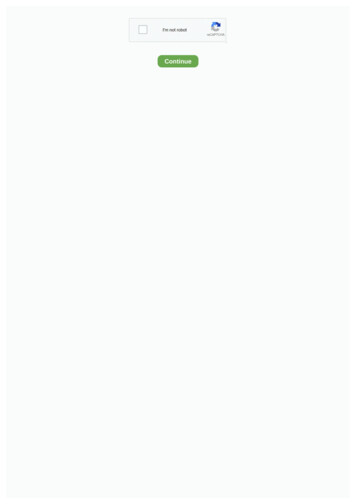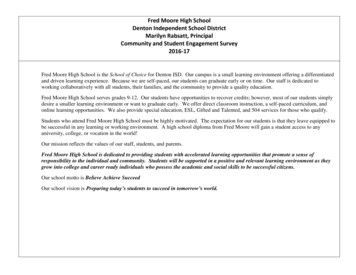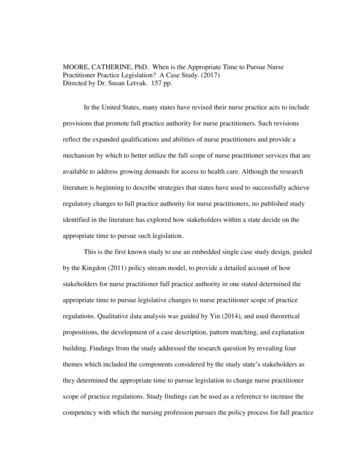
Transcription
MOORE, CATHERINE, PhD. When is the Appropriate Time to Pursue NursePractitioner Practice Legislation? A Case Study. (2017)Directed by Dr. Susan Letvak. 157 pp.In the United States, many states have revised their nurse practice acts to includeprovisions that promote full practice authority for nurse practitioners. Such revisionsreflect the expanded qualifications and abilities of nurse practitioners and provide amechanism by which to better utilize the full scope of nurse practitioner services that areavailable to address growing demands for access to health care. Although the researchliterature is beginning to describe strategies that states have used to successfully achieveregulatory changes to full practice authority for nurse practitioners, no published studyidentified in the literature has explored how stakeholders within a state decide on theappropriate time to pursue such legislation.This is the first known study to use an embedded single case study design, guidedby the Kingdon (2011) policy stream model, to provide a detailed account of howstakeholders for nurse practitioner full practice authority in one stated determined theappropriate time to pursue legislative changes to nurse practitioner scope of practiceregulations. Qualitative data analysis was guided by Yin (2014), and used theoreticalpropositions, the development of a case description, pattern matching, and explanationbuilding. Findings from the study addressed the research question by revealing fourthemes which included the components considered by the study state’s stakeholders asthey determined the appropriate time to pursue legislation to change nurse practitionerscope of practice regulations. Study findings can be used as a reference to increase thecompetency with which the nursing profession pursues the policy process for full practice
authority legislation, and can be used by stakeholders in other states as a guide for theassessment components to consider when making decisions to pursue related legislation.
WHEN IS THE APPROPRIATE TIME TOPURSUE NURSE PRACTITIONERPRACTICE LEGISLATION?A CASE STUDYbyCatherine MooreA Dissertation Submitted tothe Faculty of The Graduate School atThe University of North Carolina at Greensboroin Partial Fulfillmentof the Requirement for the DegreeDoctor of PhilosophyGreensboro2017Approved byCommittee Chair
To my husband, Christopher, and my sons, Logan and Mason. Thank you for believing inme, and for your love, sacrifice, and support.ii
APPROVAL PAGEThis dissertation written by CATHERINE MOORE has been approved by thefollowing committee of the Faculty of The Graduate School at The University of NorthCarolina at Greensboro.Committee ChairSusan LetvakCommittee MembersDebra WallaceLaurie Kennedy-MaloneLinda BurhansDate of Acceptance by CommitteeDate of Final Oral Examinationiii
ACKNOWLEDGEMENTSThis accomplishment would not have been possible without the encouragementand dedicated support of so many people. First, I would like to thank my family for theirsupport, love, encouragement, and sacrifice during this five-year academic journey. Tomy loving husband, Christopher, and my amazing sons, Logan and Mason – you are myreminder that anything is possible with determination and the love and support of anamazing family. To my parents, Greg and Teresa Walsh, and Rod and Linda Moore (allcertified registered nurse anesthetists) – my education about the expertise, dedication, andchallenges that encompass the working lives of advanced practice registered nurses beganwith you. To my sister, Amy, always ready with words of encouragement. In lovingmemory of my mother, Carolyn – it was a comfort to walk through the halls of theUniversity of North Carolina at Greensboro (UNCG) School of Nursing during each ofmy academic pursuits and see her picture with the School of Nursing’s graduating classof 1974.To my dissertation committee, Dr. Susan Letvak, Dr. Laurie Kennedy-Malone,Dr. Debra Wallace, and Dr. Linda Burhans. Thank you for your patience and supportduring this journey. Your expertise were invaluable, and it was an honor to receive yourguidance and direction during this research endeavor. I would especially like to thank mydissertation chair, Dr. Susan Letvak, for the countless hours spent with me during mydissertation research and unending encouragement. To the UNCG School of NursingFaculty, especially Dr. Denise Côté-Arsenault. Thank you for your dedication, excellentinstruction, and for teaching me the skills required to conduct this research.iv
To my study participants, thank you so much for sharing your time, expertise, andexperiences with me. Even though I cannot specifically name each of you, please knowthat this accomplishment would not have been possible without your participation in thisresearch. According to Helen Keller, “Character cannot be developed in ease and quiet.Only through experience of trial and suffering can the soul be strengthened, ambitioninspired, and success achieved.” It was my desire to accurately portray the study state’sjourney towards NP FPA as you presented it to me. The study state has a group of healthcare leaders whose strong character and desire to improve the health of the state cannotbe denied, and I feel privileged to have had the opportunity to learn from you.v
TABLE OF CONTENTSPageLIST OF TABLES . ixCHAPTERI. INTRODUCTION .1Statement of the Problem .3Purpose .3Research Question .3Significance of Study .3Theoretical Framework .4Methodology .5Assumptions.6Delimitations .6Definition of Terms.6Summary .9II. LITERATURE REVIEW .10Introduction .10Nurse Practitioners and Access to Health Care .10History of Nurse Practitioner Practice in theUnited States.10Access to Health Care in the United States .12Primary Care.14Access to Primary Care .15Research on Nurse Practitioners and Access to Care .18Comparison of Nurse Practitioners with Physicians .21Policies that Govern Nurse Practitioner Practice .21Trends in Nurse Practitioner Regulatory Changes .24Research on Factors Associated with Nurse PractitionerPractice .27Regulation of Nurse Practitioners and NursePractitioner Supply and Practice .27Barriers to Nurse Practitioner Practice .29Policy Changes for Nurse Practitioner Practice .31Gaps in the Literature.34The Study State .34Access to Health Care in the Study State .35Nurse Practitioners in the Study State .36vi
Theoretical Framework .39Kingdon Policy Stream Model .39Summary .40III. METHODOLOGY .43Introduction .43Case Study Design .43Selection of the Case .45Theoretical Propositions Within the Methodology .45Procedure .46Data .49Summary .61IV. RESULTS .62Introduction .62Sample Characteristics .63Pattern Matching .65Case Description.97Explanation Building .105Summary .107V. DISCUSSION .110Introduction .110Significant Study Findings .111Sample .111Themes .112Case Study Methodology and the Kingdon (2011)Policy Stream Model .113Limitations .116Implications.117Research Implications .117Practice Implications .119Education Implications .120Policy Implications .120Conclusions .122Summary .123REFERENCES .125vii
APPENDIX A. CASE STUDY PROTOCOL .150APPENDIX B. INTERVIEWEE TRANSCRIPT VALIDATION .154APPENDIX C. TABLE 3. DATA REFERNCE LIST EXAMPLE . 155viii
LIST OF TABLESPageTable 1. State Regulatory Categories .24Table 2. Sample Demographics (n 11) .64Table 3. Data Reference List Example .155ix
CHAPTER IINTRODUCTIONTo maximize the contributions of nurse practitioners (NPs) in a transformedUnited States (US) health care system, legislative changes at the state and federal levelare required to update and standardize scope of practice (SOP) regulations to promotepatient choice in health care providers (Institute of Medicine [IOM], 2010). Nursepractitioners are governed by their state laws, and the extent to which they are used ispartially influenced by state NP SOP regulations and policies (Federal Trade Commission[FTC], 2014; Xue, Ye, Brewer, & Spetz, 2016). Many states have revised their nursepractice acts (NPAs) to reflect the expanded qualifications and abilities of NPs in order tobetter utilize the full scope of NP services that are available to meet population needs(Cross & Kelly, 2015; Gadbois, Miller, Tyler, & Intrator, 2015; Iglehart, 2014).However, regulation remains inconsistent across the US (Gadbois et al., 2015; Lugo,O’Grady, Hodnicki, & Hanson, 2010; Schiff, 2012). Outdated, restrictive SOPregulations for NPs that remain in many states inhibit competition among health careproviders and can lead to decreased access to health care services, decreased patientchoice in health care providers, increased health care costs, decreased quality of care, anddecreased innovation in health care delivery (Center to Champion Nursing in America,2010; FTC, 2014; IOM, 2010; Lowery, Scott, & Swanson, 2015).1
In the study state for this dissertation research, the first degree-granting NPprogram was established in 1970; seven graduates completed the program in 1971(Lowery & Varnam, 2011). The study state pioneered the regulation of NPs in 1973 whenit became the first in the US to establish statutes, rules, and regulations to define NPpractice (Appalachian State University, 2016; Lowery & Varnam, 2011). In 1975, NPsgained the legal right to prescribe, compound, and dispense medications (AppalachianState University, 2016). However, early advances in the creation and regulation of the NProle in the study state required compromises, including the model of joint regulation (JR)of NPs by both the Board of Nursing and Board of Medicine, and requirements forphysician supervision of NP practice that still remain in the state (Kugler, Burhans, &George, 2011; Lowery & Varnam, 2011).Rigolosi and Salmond (2014) suggest that now is the time for states to pursuepolicy change for NP full practice authority (FPA) legislation. However, Kingdon (2011)asserts that policy change is more likely to occur when identified problems, policyproposals, and the politics surrounding an identified problem converge at the samecritical point in time, creating an open window of opportunity to push a policy proposalforward. According to Kingdon’s (2011) model, each state must assess its politicalenvironment, and competing policy problems and proposals to determine if the time isappropriate for introducing NP FPA legislation. Studies are needed to provide guidanceon how stakeholders for NP FPA legislation determine whether or not the time for statespecific legislation is appropriate based on each state’s assessment. This study is the first2
known study to provide a detailed account of how stakeholders for NP FPA in one statedetermine the appropriate time to pursue legislative changes to NP SOP regulations.Statement of the ProblemAlthough the research literature is beginning to describe strategies that states haveused to successfully achieve regulatory changes to FPA for NPs (Duncan & Sheppard,2015; Pruitt, Wetsel, Smith, & Spitler, 2002; Rigolosi & Salmond, 2014), no publishedstudy identified in the literature has explored how stakeholders within a state decide onthe appropriate time to pursue NP FPA legislation. Studies are needed to provideguidance on how stakeholders for NP FPA legislation determine whether or not thecurrent time in their specific state is appropriate.PurposeThe purpose of this study was to achieve a comprehensive understanding of howstakeholders for NP FPA in one state determine the appropriate time to pursue legislativechanges to NP SOP regulations.Research QuestionHow do one state’s stakeholders for NP FPA determine the appropriate time forpursing legislation to change NP SOP regulations?Significance of StudyThis study is important for nursing in that it is the first known study to provide adetailed account of how stakeholders for NP FPA in one state determine the appropriatetime to pursue legislative changes to NP SOP regulations. Findings from the study areuseful to the study state in that they may serve as a self-assessment of the state’s current3
political environment and readiness for legislative pursuits according to the Kingdon(2011) model. Additionally, the study’s findings are useful as a guide for stakeholders inother states that are considering the pursuit of legislation to change NP SOP regulations.Finally, findings from this study add to the body of research literature that describes thepolicy process that NPs encounter when pursuing FPA legislation.Theoretical FrameworkThe study was guided by Kingdon’s (2011) policy stream model. According toKingdon (2011), the policymaking process is dynamic and fluid, occurring in anunpredictable and chaotic environment. Within the model there are three separatestreams: the problem stream, the policy stream, and the politics stream. The streamsusually move through time separately but in parallel. However, at certain critical points intime, they converge to form an open window of opportunity in which an issue can bemoved onto the governmental agenda with the potential for action. Based on the Kingdon(2011) model, the study explored the following theoretical propositions:1. The current problems, available policy alternatives, and political environmentin the study state will influence NP FPA stakeholders to decide that the 2017legislative session is the appropriate time to introduce legislation to pursuechanges to NP SOP regulations.2. The 2017 legislative session will present an open window of opportunity forintroducing legislation for NP FPA in the study state.4
MethodologyA qualitative methodology, with an embedded single case study design was usedto conduct the proposed study. Five rationales exist for using a single case design: theidentification of a critical, unusual, common, revelatory, or longitudinal case (Yin, 2014).A critical case is beneficial for situations in which the researcher tests a previouslydeveloped theory. The single case can support a theory’s propositions or offer analternative set of explanations which can contribute to knowledge and theory building(Yin, 2014). An unusual case in one that deviates from theoretical norms or everydayoccurrences and can reveal insights about normal processes that can be connected to alarger situation beyond that of the single, identified case (Yin, 2014). The purpose of acommon case is to capture and describe the circumstances and conditions of an everydaysituation and provide insight about the social processes related to a prior theoretical areaof interest (Yin, 2014). A revelatory case is one in which the researcher has anopportunity to observe and analyze a phenomenon previously inaccessible to socialscience inquiry. In such situations, the opportunity for uncovering a previouslyinaccessible phenomenon and revealing the
To the UNCG School of Nursing Faculty, especially Dr. Denise Côté-Arsenault. Thank you for your dedication, excellent . Trends in Nurse Practitioner Regulatory Changes .24 Research on Factors Associated with Nurse Practitioner Practice.27 Regulation of Nurse Practitioners and Nurse .
